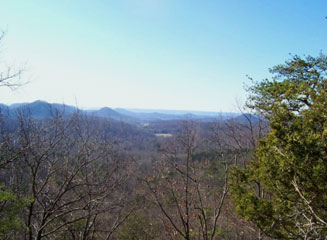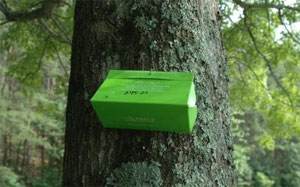originally prepared by Jim Newman, Extension Forestry Specialist
updated by Jeff Stringer, Extension Forestry Specialist, and Lee Townsend, Extension Entomologist, University of Kentucky
Kentucky's Forests
- Kentucky is third in the nation in hardwood production. Over 45% of the state's land surface (over 11 million acres) is forested.
- Kentucky lies in a transition zone between northern and southern forests. There are about 100 native species; about 50% have some commercial value and use.
- Threats to Kentucky forests from exotic invasive plants, animals, and pathogens have increased the need for people trained and certified in Forest Pest Control.

Knobs State Forest and Wildlife Management Area (forestry.ky.gov)
Kentucky's forests are dominated by deciduous or hardwood trees. Hardwoods comprise over 90% of the marketable timber volume, about half of that is various oak species. The top three lumber species are white oak, yellow poplar and red oak. The hardwood species found on any given land parcel vary with geographic location and site factors, such as aspect and soil depth, moisture, and structure. Past land use, harvesting practices, and fire history also affect species composition. Certain tree associations appear often and are classified as forest types. The principal hardwood forest types recognized by the US Forest Service in Kentucky are oak-hickory (over 4,700,000 acres), and mixed hardwoods (over 4,000,000 acres). Other hardwood forest types, which may be very important locally, are white oak, maple-beech, oak-gum-cypress, and elm-ash-cottonwood.
Conifers, including pines, redcedar, hemlock, and cypress, comprise less than 10% of the forest resource. Redcedar and Virginia pine are widely distributed and have considerable local economic importance. The pines are particularly important in and near the cliff section of the Cumberland Plateau in eastern Kentucky. In addition, forest plantations, consisting of various species of pine, have been established throughout the state.
Principles of Forest Pest Management
An understanding of pest identification and biology, along with good forest management practices, are key elements in preventing or reducing losses to pests. Use of a combination of methods in an integrated pest management (IPM) program provides a sound approach to forest health. IPM is discussed in the "Applying Pesticides Correctly" core manual.
Pest monitoring should be a part of an overall forest management plan. It can allow early detection and accurate assessment of infestations. In many cases, sound long-term production practices can minimize the need for pesticide applications. When pest outbreaks occur, suitable management alternatives will vary with the specific pest, or pest complex, and will consider damage potential, control costs and benefits, and legal, environmental, and social factors.
Insect pheromones are chemicals that members of a species use to communicate with each other. Females of many species produce sex pheromones that attract males for mating. Traps baited with pheromone lures can be used to survey for invasive insects, or in some cases, to control limited infestations. These traps are used each summer in Kentucky to monitor for the gypsy moth.

Gypsy moth trap
(Chris Evans, University of Illinois, Bugwood.org)
Management decisions should consider potential pest impacts on the environment:
 Will the problem increase, decrease, or remain the same over time?
Will the problem increase, decrease, or remain the same over time?
 What type of damage can occur and how many trees will be affected?
What type of damage can occur and how many trees will be affected?
 What will be the long term impact of the pest on trees and the environment?
What will be the long term impact of the pest on trees and the environment?
- For example, the southern pine beetle damages the cambium layer and introduces fungi that almost always kill the tree. However, many trees can recover from an almost total leaf loss from caterpillars in a single season without a long term impact on health. Insect outbreaks that last for several years can cause severe stress that will kill trees or make them susceptible to other problems.
A key part of pest management is to use a pesticide only when it is needed to prevent an unacceptable amount of damage. Use of a pesticide may not be justified if the cost of control or potential harm to the environment is greater than the estimated damage or loss.
Before choosing a control method(s):
- Correctly identify the organism.
- Assess the infestation and determine the potential economic damage.
- Determine the available control methods.
- Evaluate the benefits and risks of each method or combination of methods.
- Are there threatened or endangered species or sensitive sites in the area to be treated?
- Choose effective method(s) that will be least harm to humans and the environment.
- Follow applicable local, state and federal regulations.
- Correctly carry out the control practice(s) and keep accurate records so results can be evaluated.
A pesticide application may be needed to control a pest outbreak or to eradiate limited infestations of an invasive species. Select and use pesticides in a manner that will cause the least harm to non-target organisms in forests, seed orchards and nurseries, while still achieving the desired management goal.

Pesticide applications may be needed in some cases (english.forestry.gov.cn)
Pesticides are labeled for specific pests, crops and land-use situations. Use of insecticides, fungicides, and herbicides is common in managed seed orchards, forest nurseries, intensive short-rotation plantations, and in Christmas tree production. In general, the most commonly used forest pesticides are herbicides used for site preparation, herbaceous weed control, and in pine release treatments. Insecticide applications are seldom used in general forest management because of high treatment costs and potential effects on non-target organisms. Situations justifying the widespread use of fungicides also are rare. In some cases, vertebrate animals must be controlled through trapping or hunting but use of repellents and poison baits may be necessary.
[return]
References
Brooks, R. Forest Herbicides and their mode of action. U of Idaho CES Tree Planting and Care No. 15. Forest pest control. U Ga Special Bulletin 16 http://www.bugwood.org/pestcontrol/ Invasive plants of the eastern United States: Identification and Control. http://www.invasive.org/eastern Kentucky Woodlands Magazine Vol 1. SAF.
Herbicide use in forest management - a position of the Society of American Foresters. This publication, originally prepared by Jim Newman, Extension Forestry Specialist, is provided by the Pesticide Safety Education Program of the UK College of Agriculture.
This version has been updated by Jeff Stringer, Extension Forestry Specialist, and Lee Townsend, Extension Entomologist.
http://www.ext.colostate.edu/mg/Gardennotes/331.pdf




